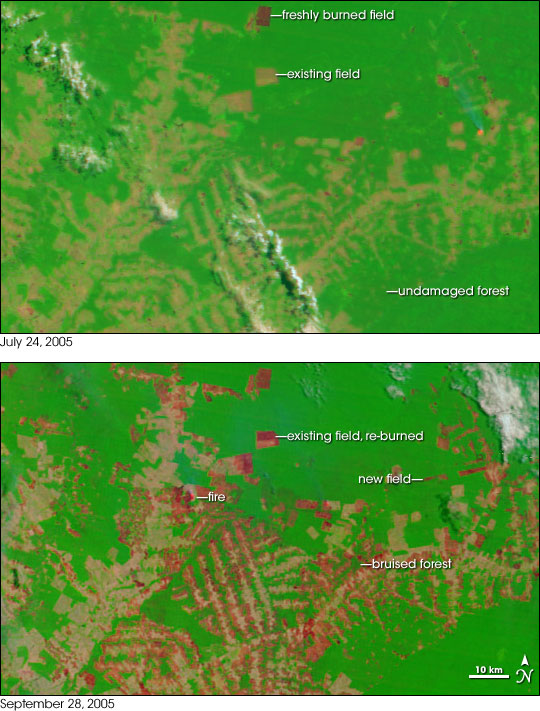

Disaster in the Making | |||
The possibility of a bad fire season began to nag Brown in July. Since April, the Acre River, which supplies most public water in the area, had been dropping. The regional water authority had to install additional pumps in the river, and then had to keep dredging a hole beneath them to keep them deep enough underwater to run correctly. Backyard wells began drying out, and cases of diarrhea began to climb as water quality declined. “In late July,” says Brown, “I wrote an article for a major regional newspaper with Nara, in which we alerted people to the idea that low water levels in the river meant that there was little water in the subsoil.” The two warned that between low ground-water levels and lack of recent rains, the rainforest that surrounds Acre’s agricultural lands would be tinder-dry when locals began burning off their fields in the coming months. In hindsight, Brown criticizes himself for not raising the alarm sooner and louder. The newspaper article led to a meeting of the state fire committee in the first part of August, and by the 17th, the state government had declared a moratorium on burning for 30 days. “Since early August, I have been getting interviewed every few days by TV and radio reporters. My neighbors tire of seeing me on the evening news. Unfortunately, my role continues to be the fifth horseman of the Apocalypse, warning about the dangers of fires getting out of control,” said Brown. Unfortunately, neither the public warnings nor the ban have been enough to stop everyone from burning. In that way, Brown said, he feels like the mythological Greek prophetess Cassandra, whose curse was to issue unfailingly accurate predictions that no one would believe. Farmers and ranchers set fire to their plots to clear off stubble or dead grass, but then they can’t contain them. Out-of-control, the fires sweep though adjacent unburned agricultural plots and devour the understory of the surrounding forest. The smoke from both local and out-of-state fires has blanketed the region for days at a time, creating a severe respiratory hazard. |
|||
 | |||
The failure of some to obey the ban on burning may in some cases represent a culture clash between rural farmers and ranchers and what some of them perceive to be repression from a distant, urban government. “The burning of agricultural plots is normally done in the days running up to Brazilian Independence Day, on September 7,” explained Brown. As farmers and ranchers are fined or arrested for illegal burning, Brown suggested that resentment and tension between Acre’s urban and rural interests could increase, especially in the face of the upcoming 2006 elections. “This drought has become a test to see if we can anticipate and adapt to climate change, whether natural or induced by human actions. The results of this test are not heartening,” said Brown. “For the past several years, Acre has been the leader for innovative government response and concern for the environment in the Amazon. But even here, our capacity for anticipating catastrophic environmental events is limited.” As of early October, conditions in Acre had not improved, and the fire ban continued. But “hot pixels” still riddle the satellite imagery of Acre, while smoke often hides the ground from view. Brown says that one solution for reducing the impact of climate disruptions like severe drought in Acre is to devise productive, fire-resistant landscapes. “The phrase is catchy,” he says, “yet I only have faint speculations of how to do so. At this time, my hope is that [through our current efforts] we can minimize the damage, and that we can view it as a trial run for future climate change.” The investment that Brazil and other countries have made in the LBA research project should provide clues on how to avoid disasters like the current fire emergency in Acre. Failure to use the episode as a lesson may lead to an increasingly bleak outlook for the conservation of forest resources. Brown’s hope is that people will have both the tools—including scientific knowledge—and the societal will to develop strategies for sustainable human presence in the Amazon. Although it’s easy to feel frustrated sometimes, Brown says he doesn’t feel hopeless. “Humans will need to climb rapidly up the learning curve in order to deal with climate change on a planet with several billion people,” he acknowledges. “But I believe that it is possible; that is why I am here.”
|
Drought-stressed forests that surround farms and ranches have gone up in flames during the agricultural burning season in Acre. These Moderate Resolution Imaging Spectroradiometer (MODIS) satellite images show some of the area before (top) and after (bottom) the peak of the 2005 agricultural burning season. Bright green indicates unburned forest, bright red indicates recently burned areas, and tan indicates cleared, but unburned land. Next to some burned fields, the forest appears dark green, or “bruised,” probably indicating places where fires escaped from fields and burned into the forest understory. (NASA images by Jesse Allen and Jeff Schmaltz) | ||